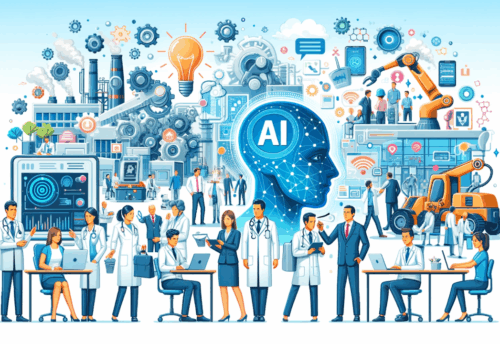
Prolonging the AI Spring for Entrepreneurs, VCs, and Corporations

The current AI spring is in full swing. Entrepreneurs remain extremely excited about generative AI, as manifested by the number of financing requests our firm and many other investors continue to receive but are starting to think more diligently about where the white space they can go after. Corporations are in testing and evaluation mode as they formulate, or reformulate, AI strategies and assess the impact that generative AI will have on their business. Venture investors remain upbeat about the sector but are also concerned about four issues.
According to PitchBook, less money was invested overall in startups during 2023 than the previous year. However, the year-over-year investment in AI startups increased. YC data shows that AI startups make up more than thirty percent of its latest cohort. The majority of the funding to AI companies went to mega-deals as the competition for the best foundation models remains fierce. Anthropic, Cohere, Mistral, xAI(?), Google, Meta, and other deep-pocketed companies are working hard to catch up with OpenAI. In this environment, many founders have moved on from trying to create yet another foundation model. We see two trends in the investment solicitations our firm receives. First, applications of AI to verticals like healthcare that incorporate industry-specific language models. These fall under our autonomous intelligent agent thesis. The models these applications incorporate may be the result of fine-tuning/adapting an existing open-source LLM. Second, infrastructure software to connect LLMs to the rest of the software ecosystem. Entrepreneurs targeting the enterprise with AI software will need to consider how enterprise AI applications are likely to evolve (see below).
During this period, VCs have to deal with the impact of aggressive hiring practices by tech leaders on startups, the market’s confusion about AI regulation, and the lack of an enduring disruptive business model that will enable AI companies to grow to the valuations they achieved in their recent financing rounds. No better examples showcasing the war for AI exist than the recent personnel problems at Inflection and Stability AI. Microsoft is aggressively trying to increase its AI talent pool. The acquisition of Inflection’s key personnel is one of the strategies it is employing. Google, Meta, Amazon, and Apple are not sitting still in this area. Apple has been particularly acquisitive. Collectively, these four companies have hired ten times more AI talent than the next five companies. Comparatively, the headcount of OpenAI, Anthropic, Mistral, and Cohere is tiny. This creates a problem for VCs as their companies cannot hire the talent with the caliber to match the valuations. In the case of Inflection and Stability, the investors saw the companies’ value evaporate overnight.
My participation in the NVCA AI working group demonstrated that there is significant confusion about the regulatory moves by the US federal and state governments. We see a lack of or uncoordinated regulation benefiting the well-funded private companies and the large public tech companies. These companies can take advantage of their position to establish beachheads and norms that will be hard to reverse. We are seeing how difficult it is to undo practices that internet and mobility companies have established over the past several years.
Private and public companies are searching for the right business models. Foundation models are expensive to build, update, and use to make inferences. The advertising business model that made it possible to offer free online search and other services does not work with generative AI. It is unclear whether the $20/month model that is used by some companies is working as expected. Casual users do not want yet another subscription. VCs must work hard to address these three issues because otherwise, they risk facing massive value loss through their AI investments.
AI will radically change enterprise software applications. Over the years we have changed the deployment model for enterprise applications from on-premise to cloud-based. However, the business logic and intelligence remained embedded in the application. The adoption of language models and intelligent agents will change this structure. First, the intelligence of enterprise applications will be provided by third parties in the form of large or small language models (xLMs for short) or intelligent agents. The enterprise will be responsible for refining the xLMs with its proprietary data and using them for inferences, or making small adaptations to customize the licensed agents. Second, in addition to the intelligence, parts of the business logic may also be supplied by the intelligent agents. Third, language models and intelligent agents will be coordinated by an orchestrator that is defined by the enterprise. The enterprise’s proprietary workflows will be defined in and managed by this orchestrator. Fourth, the orchestrator will also coordinate the application’s hybrid deployment model. Foundation models and certain agents will run in hyperscalers’ clouds, whereas the fine-tuned xLMs and several of the customized licensed agents will run closer to the user. This model will have important implications for the enterprise cybersecurity model.
Enterprises are experimenting (developing and testing) with various generative AI use cases in the process of trying to find value. We have identified tens of such enterprise cases for our customers. We find that corporations focus on use cases that support cost containment and/or productivity improvements. Various forms of customer support applications fit the former category. Software development fits the latter. Recently published CIO surveys by Morgan Stanley and RBC confirm this preference and point to only modest IT budget improvements over 2023. Developing a successful generative AI application is proving a lot harder than enterprises originally imagined when they started using ChatGPT a year ago. For 2024 generative AI projects will be supported by allocations from existing budgets. Budgets for these projects could increase in 2025 and become a separate line item if success is demonstrated this year. To capture and benefit from AI corporations must think along several dimensions and not approach AI applications in the same way they have approached incumbent enterprise applications.
As we kick off the year’s spring quarter, entrepreneurs, venture investors, and corporations will benefit greatly by assessing AI lessons of the past five quarters and devising and adopting strategies that will enable us to prolong the AI spring and not enter another AI winter.




Leave a Reply